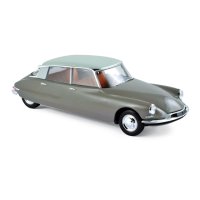DS 19 OPERATION No. DS 314-0 : Checking and adjustments on the clutch control. Op. DS 314-0 170
TOOLS
NOTE - If this pressure is greater than 425 p. 6.1. (30 kg/cm
2
), it is probably caused by piston seizure (in this
case, it is necessary to replace the piston and cylinder assembly) or a mechanical cause
Thrust race slides badly.
Fork out of alignment in relation to the thrust race.
Screw fixing the fork unscrewed (in order to retighten this screw without any dismantling, use the spanner
1705-T, see Pl. 64, fig. 3).
Bent or seized clutch fork.
Incorrect toggle adjustment . . . . . . . . . . . . . . . . . . . . . . . . . . . . . . . . . . . . . . . . . . . . . . . . . . . . . . . . . . . . . . . . . Torsion spanner 2471-T
14 mm socket
9 To check the pressure of the clutch. Spanner 1705-T
Operate the pump in order to build up the pressure to 570 p.s.i. (40 kg/cm
2
).
Release the pressure slowly by unscrewing the bleed screw “b” of the test bench.
Slowly turn the starting handle, noting the reading on the scale of the torsion spanner. Note the pressure
indicated on the pressure gauge (MI) at the precise moment that the clutch slips with a tension of 7. 2 ft/lbs (1
m.kg) being applied on the starting handle. The difference between this pressure and that in paragraph 8
should not be greater than 98 p.s.i. (7 kg/cm
2
). Untighten the bleed screw “b” of the test bench.
CHECKING THE PRESSURE OF THE HYDRAULIC GEAR SELECTOR
This check should be carried out with a warm engine, choke closed, ignition control in the midway position, clutch
engagement control spring disconnected from the accelerator control and the accelerated idling unhooked.
Apply the parking brake.
10 Using the pipe (A) or the assembly of the pipes (A) and (B), connect the end of the clutch cylinder feed pipe to the
pressure gauge (MI) of the test bench.
11 Prepare the test bench as indicated on Pl. 172 and connect the clutch cylinder to the pump of the test bench using
the pipes (A) and (B) prepared in paragraph 1 . . . . . . . . . . . . . . . . . . . . . . . . . . . . . . . . . . . . . . . . . . . . . . . . . . Test bench 2290-T
12 Tighten the bleed screw “b” of the test bench and operate the pump in order to raise the pressure in the clutch
cylinder to approximately 995 p.s.i. (70 kg/cm
2
).
13 Put the auxiliary clutch control lever in the normal running position.
With the engine idling (550 r.p.m. checked with a revolution counter, see paragraph 17 below). Engage first
gear. The pressure indicated on the pressure gauge (MI) should be 420 p. s. 1. (29 kg/cm
2
) minimum.
14 Stop the engine. The pressure (MI) should increase to 530 to 690 p.s.i. (37 to 48 kg/cm
2
).This pressure is not
constant; the needle of the pressure gauge should swing between these two figures (37 to 48 kg/cm
2
).
If the movement of the needle of the pressure gauge is not steady, this points to the bad grooving of the 38 mm
diameter piston, or the automatic clutch control valve (19) (see Pl. 70, fig. 1).

